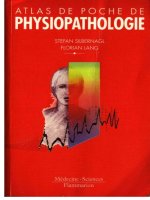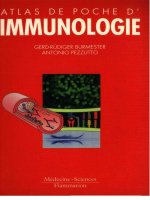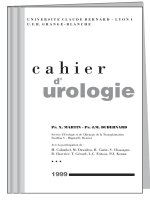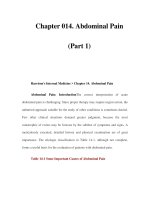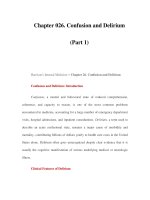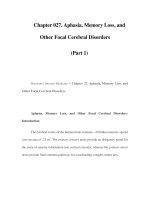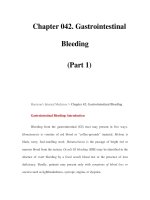ACUTE MEDICAL EMERGENCIES - PART 1 pdf
Bạn đang xem bản rút gọn của tài liệu. Xem và tải ngay bản đầy đủ của tài liệu tại đây (427.71 KB, 47 trang )
ACUTE MEDICAL EMERGENCIES
00-AcuteMed-Prelims-cpp 28/9/2000 3:13 pm Page i
USEFUL WEBSITE ADDRESSES
Advanced Life Support Group
Best Evidence in Emergency Medicine
Evidence based on-call />Royal College of Physicians />00-AcuteMed-Prelims-cpp 28/9/2000 3:13 pm Page ii
ACUTE MEDICAL
EMERGENCIES
The Practical Approach
Advanced Life Support Group
00-AcuteMed-Prelims-cpp 28/9/2000 3:13 pm Page iii
© BMJ Books 2001
BMJ Books is an imprint of the BMJ Publishing Group
All rights reserved. No part of this publication may be reproduced, stored in a retrieval system, or trans-
mitted, in any form or by any means, electronic, mechanical, photocopying, recording and/or otherwise,
without the prior written permission of the publishers.
First published in 2001
by BMJ Books, BMA House, Tavistock Square,
London WC1H 9JR
www.bmjbooks.com
British Library Cataloguing in Publication Data
A catalogue record for this book is available from the British Library
ISBN 0-7279-1464-2
Cover design by Goodall James, Bournemouth, Dorset
Typeset by Phoenix Photosetting, Chatham, Kent
Printed and bound by J W Arrowsmith Ltd, Bristol
00-AcuteMed-Prelims-cpp 28/9/2000 3:13 pm Page iv
CONTENTS
Working Group vii
Contributors viii
Preface ix
Acknowledgments x
PART I: INTRODUCTION
Chapter 1 Introduction 3
Chapter 2 Recognition of the medical emergency 7
PART II: STRUCTURED APPROACH
Chapter 3 A structured approach to medical emergencies 15
Chapter 4 Airway assessment 29
Chapter 5 Breathing assessment 39
Chapter 6 Circulation assessment 51
Chapter 7 Disability assessment 63
PART III: PRESENTING COMPLAINTS
Chapter 8 The patient with breathing difficulties 83
Chapter 9 The patient with shock 113
Chapter 10 The patient with chest pain 137
Chapter 11 The patient with altered conscious level 147
Chapter 12 The collapsed patient 171
Chapter 13 The overdose patient 185
Chapter 14 The patient with a headache 193
Chapter 15 The patient with abdominal pain 211
Chapter 16 The patient with hot red legs or cold white legs 237
Chapter 17 The patient with hot and/or swollen joints 245
Chapter 18 The patient with a rash 255
v
00-AcuteMed-Prelims-cpp 28/9/2000 3:13 pm Page v
PART IV: FAILURES
Chapter 19 Organ failure 269
PART V: SPECIAL CIRCUMSTANCES
Chapter 20 The elderly patient 297
Chapter 21 Transportation of the seriously ill patient 309
PART VI: INTERPRETATION OF EMERGENCY INVESTIGATIONS
Chapter 22 Acid–base balance and blood gas analysis 323
Chapter 23 Dysrhythmia recognition 343
Chapter 24 Chest X-ray interpretation 365
Chapter 25 Haematological investigations 371
Chapter 26 Biochemical investigations 383
PART VII: PRACTICAL PROCEDURES
Chapter 27 Practical procedures: airway and breathing 391
Chapter 28 Practical procedures: circulation 407
Chapter 29 Practical procedures: medical 415
PART VIII: APPENDIX
Drugs commonly used in the management of medical emergencies 425
Answers to Time Out Questions 429
Index 441
CONTENTS
vi
00-AcuteMed-Prelims-cpp 28/9/2000 3:13 pm Page vi
WORKING GROUP
P Driscoll Emergency Medicine, Manchester
R Kishen Anaesthesia/ICU, London
K Mackway-Jones Emergency Medicine, Manchester
G McMahon Emergency Medicine, Manchester
F Morris Emergency Medicine, Sheffield
TD Wardle General Medicine, Chester
B Waters Anaesthesia/ICU, North Wales
J Whitaker Care of the Elderly, Harrogate
S Wieteska ALSG, Manchester
vii
00-AcuteMed-Prelims-cpp 28/9/2000 3:13 pm Page vii
CONTRIBUTORS
M Bhushan Dermatology, Manchester
P Davies Emergency Medicine, Bristol
P Driscoll Emergency Medicine, Manchester
CEM Griffiths Dermatology, Manchester
C Gwinnutt Anaesthesia, Manchester
J Hanson Emergency Medicine, Preston
R Kishen Anaesthesia/ICU, London
K Mackway-Jones Emergency Medicine, Manchester
A McGowan Emergency Medicine, Leeds
G McMahon Emergency Medicine, Manchester
F Morris Emergency Medicine, Sheffield
C Moulton Emergency Medicine, Bolton
K Reynard Emergency Medicine, Manchester
P Sammy General Practice, Manchester
P Terry Emergency Medicine, Manchester
D Wallis Emergency Medicine, London
TD Wardle General Medicine, Chester
B Waters Anaesthesia/ICU, North Wales
J Whitaker Care of the Elderly, Harrogate
viii
00-AcuteMed-Prelims-cpp 28/9/2000 3:13 pm Page viii
PREFACE
This book has been written to enable health care workers to understand the principles of
managing an acute medical emergency safely and effectively. To achieve this aim it pro-
vides a structured approach to medical emergencies, describing relevant pathophysiology
that will also help to explain physical signs and the rationale behind treatment.The first
edition of this manual (written by Terry Wardle) has undergone significant modification
directed by the working group and also, in particular, candidates from the first
MedicALS courses. The requirements of these contributing doctors has meant that the
contents and associated information may initially appear skewed – but this is evidence
based.
Most text books are out of date by the time they are published – this manual is differ-
ent in that it is both pragmatic and dynamic. Medicine is a rapidly evolving discipline
and in order to ensure that this manual remains dynamic and up to date, reference web
sites are available to ensure that the reader has constant access to relevant information.
This will facilitate continual professional development that is the responsibility of the
individual.
The book provides a structured approach that is applicable to all aspects of acute
medicine, ensures the early recognition of signs of critical illness and will empower the
individual to take immediate and appropriate action.
The text alone cannot provide all the necessary knowledge and skills to manage an
acute medical emergency, therefore readers are encouraged to attend the MedicALS
course to further their theoretical and practical knowledge.
This book will continue to change to include new evidence based practices and proto-
cols to ensure a solid and safe foundation of knowledge and skills in this era of clinical
governance.
Continued professional development is mandatory for all medical practitioners. This
manual and the associated course will ensure both new knowledge acquisition and
revision – and stimulate further learning.
ix
00-AcuteMed-Prelims-cpp 28/9/2000 3:13 pm Page ix
ACKNOWLEDGMENTS
We would like to thank members of faculty and candidates who have completed the
MedicALS course for their constructive comments that have shaped both the text and
the course.
We would also like to thank Helen Carruthers, MMAA for her work on many of the
figures within the text.
Finally, our thanks to the members of staff both at the BMJ and within ALSG for their
on-going support and invaluable assistance in the production of this text.
x
00-AcuteMed-Prelims-cpp 28/9/2000 3:13 pm Page x
PART
I
INTRODUCTION
01-AcuteMed-1-cpp 28/9/2000 3:23 pm Page 1
This Page Intentionally Left Blank
CHAPTER
1
Introduction
INTRODUCTION
After reading this chapter you will understand:
● the current problems in the assessment of acute medical emergencies
● the need for a structured approach to the medical patient.
THE PROBLEM
A medical emergency can arise in any patient, under a variety of circumstances, for
example:
● a previously fit individual
● acute on chronic illness
● post surgical
● precipitating or modifying the response to trauma.
The acute problem can be directly or indirectly related to the presenting condition,
an associated complication, any treatment instituted, and the result of inappropriate
action.
Furthermore, with the increase in the elderly population there is a corresponding
increase in the number and complexity of medical problems. The management of such
patients is compromised by the drive to cut costs, but maintain cost effective care; ensure
efficient bed usage; reduce junior doctors’ hours; and increase medical specialisation.
There is an annual increase of emergency admissions in excess of 5% and they account
for over 40% of all acute National Health Service beds. In the UK the mean hospital bed
complement is 641, but only 186 are allocated for medical patients with an average 95%
of these housing medical emergencies.
The common acute conditions can be broadly classified according to the body system
affected (Table 1.1).
Key point
Inappropriate action costs lives
3
Reading: 15 minutes
01-AcuteMed-1-cpp 28/9/2000 3:23 pm Page 3
Table 1.1. Classification of medical emergencies
This information may be broken down further to reveal the common reasons for
admission:
● myocardial infarction
● stroke
● cardiac failure
● acute exacerbation of asthma
● acute exacerbation of chronic obstructive pulmonary disease
● deliberate self harm.
Despite the fact that these are common conditions, frequent management errors and
inappropriate action result in preventable morbidity and mortality.
A recent risk management study examined the care of medical emergencies. One or
more avoidable serious adverse clinical incidents were reported. Common mistakes are
listed in the box.
This was only a small study but of the 29 patients who died, 20 would have had a good
chance of long term survival with appropriate management. In addition, of the 11
patients who survived, three were left with serious neurological defects, three underwent
avoidable intestinal resection and four patients suffered unnecessary prolonged hospital
admission.
Diagnostic errors were made in 80% of patients because of inadequate interpretation
of the clinical picture and initial investigations. These errors are given in the box.
Errors in patient assessment
● Available clinical evidence incorrectly interpreted
● Failure to identify and focus on very sick patients
● Investigations misread or ignored
● Radiological evidence missed
● Standard procedures not followed
● Inadequate assessment or treatment
● Discharge from hospital without proper assessment
Common mistakes
● Failure to recognise and treat serious infection
● Error in investigating – acute headache
acute breathlessness
epilepsy
● Misinterpretation of investigations
● Inadequate assessment of abdominal symptoms
Type %
Cardiac 29
Respiratory 26
Neurological 21
Gastrointestinal 13
ACUTE MEDICAL EMERGENCIES: THE PRACTICAL APPROACH
4
01-AcuteMed-1-cpp 28/9/2000 3:23 pm Page 4
The overall problems were identified as follows:
● medical emergencies were not assessed by sufficiently experienced staff
● a second opinion was not obtained
● assessment was inadequately performed before discharge
● X-rays were not discussed with radiologists
● protocols were not used for standard conditions.
Furthermore, the assessment of medical patients for intensive care was either incom-
plete, inappropriate or too late to prevent increased morbidity and mortality.
Therefore, there are problems in the
fundamental areas of medical patient care, i.e.
clinical examination, requesting appropriate investigations and their correct interpreta-
tion, and communication. However, probably most important of all, knowing when and
who to ask for help. One answer to this important problem is to provide a structured
approach to patient assessment that will facilitate problem identification and prioritise
management.
All that is required to manage medical emergencies is focused knowledge and basic
skills. These will ensure prompt accurate assessment and improve patient outcome.
Avoidable deaths are due to inappropriate management, indecision or delays in treat-
ment. Another important issue is the time patients wait for appropriate medical care.The
average time for initial review after admission is 30 minutes with a further 130 minutes
passing before definitive management occurs.
In the United Kingdom, numerous studies have shown that specialist care is better
than that provided by a generalist; for example, prompt review by a respiratory physician
has been shown to reduce both morbidity and mortality from asthma. The mortality
from gastrointestinal haemorrhage falls from 40% to approximately 5% if the manage-
ment is provided by a specialist in gastroenterology. Further supportive evidence has
been provided by studies in the United States where mortality from myocardial infarc-
tion or unstable angina was greater in patients managed by generalists.
However, there are insufficient numbers of “specialists” to manage all of these condi-
tions and some will require review by a general physician.
Thus, physicians need to know how to manage medical emergencies. This course will
teach a structured approach for assessment that will enable you to deliver safe, effective,
and appropriate care.
Traditional medical teaching dictates that a history should always be taken from the
patient before the clinical examination. This will subsequently allow a diagnosis or
differential diagnosis to be postulated and dictate the investigations required.
Unfortunately this approach is not always possible; for example, trying to obtain a
history from a patient who presents with breathlessness may not only exacerbate the con-
dition but also delay crucial therapy.
This course has been developed by observing how experienced physicians manage
medical emergencies.The results have shown quite an interesting cultural shift. Most of
us, as we approach the patient, quickly scan for any obvious physical signs, for example
breathlessness, and then focus our attention on the symptoms until the diagnosis is iden-
tified. Only when the patient’s symptoms have been improved can a history be taken and
the remainder of the examination performed. This process has been refined and for-
malised to produce a structured approach to patient assessment.This will ensure that the
most immediately life threatening problems are identified early and treated promptly. All
other problems will be identified subsequently as part of the overall classical approach to
the medical patient, i.e. taking a history and examining the patient.
However, if the patient deteriorates at any stage a reassessment should start at the
beginning. Thus, this structured approach considers the conditions that are most likely
to kill the patient. If these are excluded the physician will then have time to approach the
patient in a traditional fashion.
INTRODUCTION
5
01-AcuteMed-1-cpp 28/9/2000 3:23 pm Page 5
The key principles of MedicALS are shown in the box.
SUMMARY
The number and complexity of acute medical emergencies are increasing. However, the
majority of mistakes result from a failure to assess acutely ill patients, interpret relevant
investigations, and provide appropriate management. This manual and the associated
course will equip you with both knowledge and skills to overcome these difficulties and
provide safe, effective, and appropriate care.
Key principles of MedicALS
● Do no further harm
● Focused knowledge and basic skills are essential
● A structured approach will identify problems and prioritise management
● Prompt accurate assessment improves patient outcome
ACUTE MEDICAL EMERGENCIES: THE PRACTICAL APPROACH
6
01-AcuteMed-1-cpp 28/9/2000 3:23 pm Page 6
CHAPTER
2
Recognition of the medical emergency
OBJECTIVES
After reading this chapter you will be able to:
● understand the clinical features of potential respiratory, cardiac, and neurological
failure
● describe these clinical features and use them to form the basis of the primary assessment.
Irrespective of underlying pathology, the acute medical patient will die from failure of
either the respiratory, circulatory or central neurological systems, or a combination of
these. It is therefore of paramount importance that the physician can recognise
poten-
tial failure
of these three systems as early recognition and management will reduce
morbidity and mortality. The ultimate failure, a cardiorespiratory arrest, is too large a
topic to be added to this course.
This chapter will provide an overview of the clinical assessment of patients with poten-
tial respiratory, circulatory, and neurological failure.The chapters in Part II will then use
this format to develop an in-depth assessment that will eventually produce a structured
approach to the patient with a medical emergency.
RECOGNITION OF POTENTIAL RESPIRATORY FAILURE
This can be quickly assessed by examining the rate, effort, symmetry, and effectiveness
of breathing.
Respiratory rate
The normal adult respiratory rate is 14–20 breaths per minute.Tachypnoea (greater than
30 breaths per minute at rest) indicates that increased ventilation is needed because of
hypoxia associated with either disease affecting the airway, lung or circulation, or meta-
bolic acidosis. Similarly, a respiratory rate ≤10 breaths per minute is an indication for
ventilatory support.
Effort of respiration
If the patient can count to 10 in one breath there is usually no significant underlying
respiratory problem. Other features which suggest increased respiratory effort are
7
Reading: 15 minutes
02-AcuteMed-2-cpp 28/9/2000 3:25 pm Page 7
intercostal and subcostal recession, accessory muscle use, and a hoarse inspiratory noise
while breathing (stridor; this is a sign of laryngeal/tracheal obstruction). In severe
obstruction, stridor may also occur on expiration but the inspiratory component is usu-
ally more pronounced. In contrast, lower airway narrowing results in either wheezing
and/or a prolonged expiratory phase.
Symmetry of breathing
Asymmetrical chest expansion suggests an abnormality on the side with reduced move-
ment.
Effectiveness of breathing
Chest expansion will indicate the volume of air being inspired and expired. Similar find-
ings will be obtained from auscultation.
Pulse oximetry can be used to measure the arterial oxygen saturation (
SaO
2
). These
instruments are inaccurate when the
SaO
2
is below 70%, there is poor peripheral perfu-
sion, and in the presence of carboxyhaemoglobin.
Effects of respiratory inadequacy on other organs
Heart rate
Hypoxaemia produces a tachycardia; however, anxiety and fever will also contribute to
this physical sign, making it non-specific. Severe or prolonged hypoxia eventually will
lead to a bradycardia – a preterminal sign.
Skin colour
Hypoxaemia, via catecholamine release, produces vasoconstriction and hence skin pal-
lor. Cyanosis is a sign of severe hypoxaemia. Central cyanosis in acute respiratory disease
is indicative of imminent respiratory arrest. In the anaemic patient, cyanosis may be dif-
ficult to detect despite profound hypoxaemia.
Mental status
The hypoxaemic patient will appear agitated and eventually will become drowsy. Similar
features will also occur with hypercapnoea and the patient will also exhibit vasodilatation
and a flapping tremor (asterixis). If the hypoxaemia is not treated cerebral function will
be affected.
RECOGNITION OF POTENTIAL CIRCULATORY FAILURE
Heart rate
This increases in the shocked patient due to catecholamine release, e.g. secondary to a
decreased circulatory volume. There are many reasons why a normal adult may experi-
ence a tachycardia (pulse rate >100). Other signs should be sought to confirm the clini-
cal suspicion of circulatory failure.
Key point
A silent chest is an extremely worrying sign
ACUTE MEDICAL EMERGENCIES: THE PRACTICAL APPROACH
8
02-AcuteMed-2-cpp 28/9/2000 3:25 pm Page 8
Effectiveness of circulation
Pulse
Although blood pressure is maintained until shock is very severe (loss of at least one
third of the circulating volume) a rapid assessment of perfusion can be gained by
examining peripheral and central pulses. The radial pulse will disappear if the systolic
blood pressure is below 80 mm Hg. Thus the combination of absent peripheral pulses
and weak central pulses is a sinister sign indicating advanced shock and profound
hypotension.
Perfusion
Capillary refill following pressure on a digit for five seconds should normally occur
within two seconds. A longer time indicates poor skin perfusion. However, this sign is not
valid if the patient is hypothermic.
Blood pressure
Hypotension in circulatory failure is an indicator of increased mortality. Always ensure
that an appropriate cuff size is used to take the blood pressure.
Effects of circulatory inadequacy on other organs
Respiratory system
A rapid respiratory rate with an increased tidal volume, but no signs of increased respi-
ratory effort, is predominantly caused by a metabolic acidosis associated with circulatory
failure.
Skin
Mottled, cold, pale skin peripherally indicates poor perfusion.
Mental status
Agitation, confusion, drowsiness, and unconsciousness are the progressive stages of dys-
function associated with circulatory failure.These features are attributed to poor cerebral
perfusion.
Urinary output
A urine output of less than 0.5 ml/kg/hour indicates inadequate renal perfusion during
shock.
RECOGNITION OF POTENTIAL CENTRAL NEUROLOGICAL
FAILURE
Both respiratory and circulatory failure will have central neurological effects. The oppo-
site situation also occurs; for example, patients who have status epilepticus will have
respiratory and circulatory consequences.
Conscious level
A rapid assessment of the patient’s conscious level can be made by assigning the patient
to one of the categories shown in the box.
RECOGNITION OF THE MEDICAL EMERGENCY
9
02-AcuteMed-2-cpp 28/9/2000 3:25 pm Page 9
A painful stimulus should be applied by pressure over the superior orbital ridge. An
adult who either only responds to pain or is unconscious has a significant degree of coma
equivalent to 8 or less on the Glasgow Coma Scale.
Posture
Abnormal posturing such as decorticate (flexed arms, extended legs) or decerebrate
(extended arms, extended legs) is a sinister sign of brain dysfunction. A painful stimulus
may be necessary to elicit these signs.
Pupils
Many drugs and cerebral lesions have effects on pupil size and reactions. The most
important pupillary signs to seek are dilation, unreactivity, and inequality.These indicate
possible serious brain disorders.
Respiratory effects of central neurological failure on other systems
There are several recognisable breathing patterns associated with raised intracranial
pressure. However, they are often changeable and may vary from hyperventilation to
periodic breathing and apnoea. The presence of any abnormal respiratory pattern in a
patient with coma suggests brain stem dysfunction.
Circulatory effects of central neurological failure
Systemic hypertension with sinus bradycardia indicates compression of the medulla
oblongata caused by herniation of the cerebellar tonsils through the foramen magnum.
This is a late and preterminal sign.
TIME OUT 2.1
List the clinical features that can be used to diagnose potential failure of:
a. respiration
b. circulation
c. central neurological function.
Note how many features assess more than one system. Rearrange your list of clinical
features into a logical order to produce a system for rapid assessment.
AVPU grading of consciousness
A alert
V response to
voice
P response to
pain
U
unresponsive
ACUTE MEDICAL EMERGENCIES: THE PRACTICAL APPROACH
10
02-AcuteMed-2-cpp 28/9/2000 3:25 pm Page 10
SUMMARY
In the acutely ill medical patient a rapid examination will detect potential respiratory,
circulatory, and neurological failure. The clinical features are:
● respiratory – rate, effort, and effectiveness of respiration
● circulatory – heart rate and effectiveness
● neurological – conscious level, posture, and pupils.
These features will form the framework of the primary assessment. The components
will be discussed in detail in Part II.
RECOGNITION OF THE MEDICAL EMERGENCY
11
02-AcuteMed-2-cpp 28/9/2000 3:25 pm Page 11
This Page Intentionally Left Blank
PART
II
STRUCTURED APPROACH
03-AcuteMed-3-cpp 28/9/2000 3:30 pm Page 13
This Page Intentionally Left Blank
